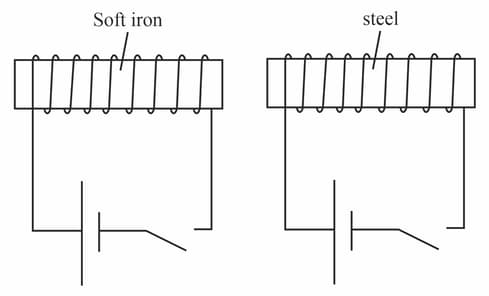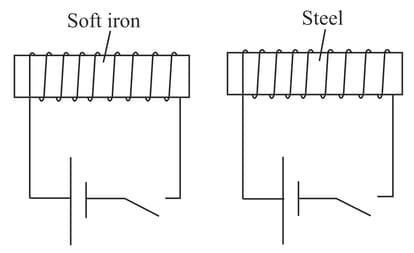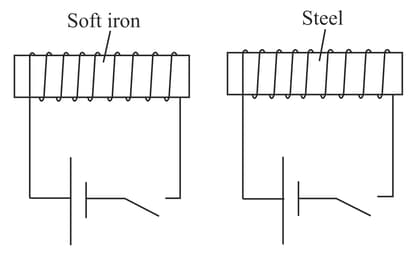David Sang Solutions for Chapter: Magnetism, Exercise 4: End-of-chapter questions
David Sang Physics Solutions for Exercise - David Sang Solutions for Chapter: Magnetism, Exercise 4: End-of-chapter questions
Attempt the free practice questions on Chapter 16: Magnetism, Exercise 4: End-of-chapter questions with hints and solutions to strengthen your understanding. Cambridge IGCSE® Physics Coursebook Second Edition solutions are prepared by Experienced Embibe Experts.
Questions from David Sang Solutions for Chapter: Magnetism, Exercise 4: End-of-chapter questions with Hints & Solutions
A soft-iron rod and a steel rod each have coils around them. Both rods are initially un-magnetised. The coils are attached to circuits, as shown in the below diagram.

Copy the table below, referring to the soft-iron rod and the steel rod shown in the above diagram.
Use the following statements to complete the table.
Magnetised loses its magnetism keeps its magnetism
| Switch closed | Switch open | |
| Soft iron | ||
| Steel |
A soft-iron rod and a steel rod each have coils around them. Both rods are initially un-magnetised. The coils are attracted to circuits, as shown in the second diagram.

Which words apply to the force between the rods when the switches are closed? Choose one from:
no force attractive force repulsive force
A soft-iron rod and a steel rod each have coils around them. Both rods are initially un-magnetised. The coils are attracted to circuits, as shown in the second diagram.

Which of the two arrangement would be used as the electromagnet on the crane in a scrap metal yard?
A soft-iron rod and a steel rod each have coils around them. Both rods are initially un-magnetised. The coils are attracted to circuits, as shown in the second diagram.

State one advantage that an electromagnet could have in comparison with similar-sized permanent magnet?
State two advantages that electromagnets have, compared with permanent magnets.
For each of the lists below, choose the option that should be used to give the strongest electromagnet.
Number of turns on coil:
For each of the lists below, choose the option that should be used to give the strongest electromagnet.
Type of core:
air plastic iron
For each of the lists below, choose the option that should be used to give the strongest electromagnet.
Current:
